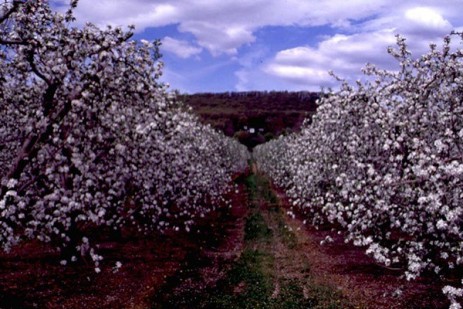There have been reports of green-tip on Gala apples across Pennsylvania, even up in Erie and Lackawanna counties.
If you use the Cornell thinning model or plan to, you need to record the green-tip stage of your apple cultivars. The model starts calculating carbohydrate production beginning with green-tip. In central PA I recorded green-tip March 28 on Gala. I also noted that some cultivars are more advanced than Gala.

Left – Half-inch green-tip. Right – 11.5 mm diameter fruit. Photos: Rob Crassweller/ Penn State
As you know, the carbohydrate model originally created by Alan Lakso was designed to attempt to predict thinner responses prior to the application thinners to allow growers to adjust thinner rate and timing for optimal results. Recently this has been referred to as “Precision Chemical Thinning” (Robinson et al. 2020).
There is a change in the carbohydrate model from previous years. New parameters have been added in developing the thinning recommendations—Percent Spurs Flowering and Growing Degree Days at 4°C. These two new data measurements were developed after a review of 12 years of data from thinning studies by Terence Robinson and his coworkers up in Geneva. Initially, parameters that factored into thinning response were primarily environmental factors such as temperature and estimated carbohydrate production as influenced by temperature and sunlight levels.
The percent of flowers flowering was added because it has been shown that if you have a greater number of flowers the potential for the number of fruits will be greater and vice versa. In other words, when you start with more flower clusters you always end up with more fruit. The number of flowers in the spring is the result of the crop load from the previous season. For most apple cultivars crop density values of 5 to 8 fruit/sq. centimeter of trunk cross-sectional area is the ideal crop load. Large fruited and/or biennial bearing cultivars like Honeycrisp should be on the lower end of that spectrum. While small-fruited early maturing cultivars like Gala should be at the upper end of that range.
Last year many growers had lower crop loads because we had two frost events one on April 17, 2020 , and the other on May 9, 2020, that reduced the crop density on their apple trees. Therefore, many of the apple cultivars will have a high number of flowers this year.
To compensate for this seasonal variation the percent flowering spurs was added to the model. The user will be required to input an estimate of the percent of spurs that are flowering in one of four ranges (0-25, 26-50, 51-75, or 76-100%). Under the Precision Chemical Thinning protocol, it is recommended to select two branches on a tree and count the number of spurs and the number of flowering spurs at tight to open cluster to determine the percentage of spurs flowering.
While counting may provide precise data on the percent flowering spurs it could be time-consuming. Over the years, Don Smith who has been working with me for 25 years has developed a visual rating system. He uses a 0 to 5 scale of 0 = no clusters, 3 = full crop to 5 = snowball bloom. You should certainly be able to develop a similar ranking to make an assessment of the percentage flowering spurs in your various orchard blocks.
The other new parameter in the model is the determination of growing degree days (GDD); with a base temperature of 4°C. A review of the Cornell research trials showed that the greatest reduction in fruit set occurred when thinners were applied around 200 to 250 GDD4°C after full bloom; which was approximately 14 days after petal fall. There were some variations by year but in general fruit size was about 11–12 mm in diameter. Over the course of the 12 year period the impact of the carbohydrate balance was greatest at the 200-250 GDD and was less at earlier or later timing. Of course, this assumes that thinner application timing has favorable sunlight, temperature, and other moisture parameters at your particular orchard location.
Finally, the model now looks at an average carbohydrate balance for the 2 days before applying thinners and the predicted weather for the next 4 days as it may impact carbohydrate production.
Unfortunately, in recent years our unpredictable and often fast-changing weather forecasts have been problematic. Nonetheless, the thinning recommendations are based on a three-dimensional lookup table considering GDD from bloom, percent spurs that are flowering, and the carbohydrate balance over a seven-day period. The thinning recommendation table is color-coded to indicate A) high risk of overthinning in red; B) slight caution of possible aggressive thinning efficiency in yellow; C) good thinning efficacy in green, and D) little or no thinning efficacy in blue.
Is the model perfect? Probably not, however, it does try to remove some of the ‘guesstimating’ out of chemical thinning. Fruit thinning continues to be one of the most important aspects of the economics of apple production.
If you have more questions on how the new MaluSim model works I would recommend that you look up the reference listed below.
– Robert Crassweller, Penn State University

















